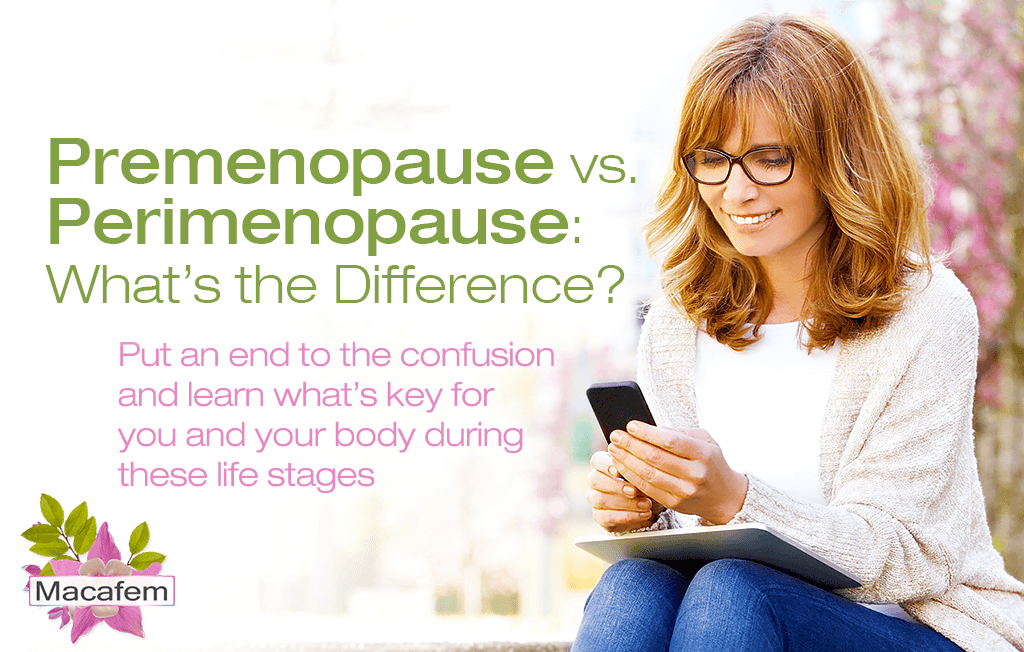Premenopause vs. Perimenopause: What’s the Difference?
Whether it’s during a doctor’s visit or while doing research online, women often find themselves scratching their heads trying to figure out whether they’re already in menopause or not. Indeed, menopause terminology is a common source of confusion. Luckily for you, we’re about to debunk it. Keep on reading to find out what’s the difference between pre- and perimenopause!

What’s Pre- and Perimenopause, and When do They Start?
First things first, premenopause is the first stage in a woman’s reproductive life. For most, it begins at puberty and ends around mid-40s. Since these are the most fertile years, premenopause is the best time to get pregnant, if a woman chooses to do so.
Perimenopause, on the other hand, is the stage that follows premenopause. It usually starts in a woman’s mid-40s and ends with the arrival of menopause. The average age at which women enter menopause (that is, stop having periods for 12 months in a row) is 51, which means that perimenopause can extend from 2 to 10 years.
What Happens during Pre- and Perimenopause?
During premenopause, most women will experience regular monthly menses with only mild discomforts related to cyclical hormonal fluctuations from periods or ovulation. Some, however, may suffer from stronger symptoms of premenstrual syndrome (PMS), such as breast tenderness, cramps, and mood swings.
Since perimenopause is the start of the menopausal transition, it’s natural to expect more intense symptoms, triggered by rapid hormonal shifts. This is the time when a woman’s fertility comes to an end, and she begins to have irregular periods, hot flashes, vaginal dryness, and more. Some of them may persist into postmenopause.
How Can I Take Care of Myself During Pre- and Perimenopause?
While healthy women generally don’t have major symptoms during premenopause, poor lifestyle habits can lead to hormonal disorders or other conditions that will compromise their health and reduce their fertility. As such, eating healthily, maintaining proper weight, and reducing stress can fend off potential imbalances.
With hormonal shifts during perimenopause, it’s common for women to struggle with symptoms, including putting on weight. As such, keeping active, finding a support group, and adding extra servings of phytoestrogenic foods to a daily diet (e.g. soy, flax, tomatoes, and oats) can help counteract these new changes.
Can Macafem Help Me Maintain Hormonal Balance During Pre- and Perimenopause?
Yes! Maintaining hormonal equilibrium is key no matter one’s reproductive stage. Luckily, various Macafem products can cover women’s most essential needs during premenopause, perimenopause, and beyond.
Macafem is an all-natural supplement that nourishes the endocrine glands to optimize their function and prompt them to improve their own hormone production. This eases discomforts caused by natural hormonal fluctuations and helps women feel more in control over their bodies and minds during this uncertain time.
How to Choose the Right Macafem Supplement for My Needs
Choosing between the three available Macafem supplements to fit your needs is easy and straight-forward!
Women in premenopause may keep their menses smooth and regular with Macafem Healthy Periods, while those seeking to boost their fertility to get pregnant faster would greatly benefit from Macafem Conceiving.
Whereas, for middle-aged women passing through perimenopause, the main(and most popular) Macafem supplement will help them ease the effects of changing hormones and lessen the severity of their symptoms.
Now that you know what’s the difference between premenopause and perimenopause, the next step is to take action towards giving your body what it needs to thrive during those natural life phases. With a healthy meal plan, regular workouts, and your best ally, Macafem, you’ll be ready to deal with anything life stages throw at you!
2. The North American Menopause Society. (n.d.). Menopause 101: A primer for the perimenopausal. Retrieved October 27, 2020 fromhttps://www.menopause.org/for-women/menopauseflashes/menopause-symptoms-and-treatments/menopause-101-a-primer-for-the-perimenopausal
3. Cleveland Clinic. (2019). Menopause, Perimenopause and Postmenopause. Retrieved October 27, 2020 fromhttps://my.clevelandclinic.org/health/diseases/15224-menopause-perimenopause-and-postmenopause
4. Women’s Health Research Institute. (n.d.). Stages of Menopause. Retrieved October 27, 2020 from https://menopause.northwestern.edu/content/stages-menopause

